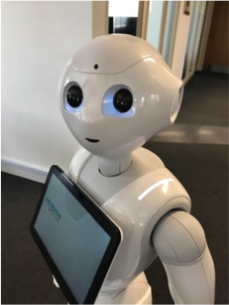by Finnoula Taylor, MSc Graduate in Artificial Intelligence at the University of Sussex and Janice Hughes, Founder and CEO of Redshift Strategy
According to one hedge fund manager the machines will have taken over within a hundred years. The human race as we know it today will have lost control due to our inability to comprehend and master trillions of very different networks and data points simultaneously.
In a recent test, Facebook found two AI machines, Bob and Alice communicating in their own derived shorthand language, well beyond the limits of human comprehension. Added to this Elon Musk and Sam Altman are concerned that AI will create a dystopian apocalypse. They see the human mind hard wired through a neural lace into supercomputers and they fear that this could represent “humanity’s biggest existential threat”. From these fears they have created “OpenAI” a non-pro t research company to ensure that the bene ts of AI are spread widely and that Artificial
Intelligence does not become a threat to civilization.
Within the next two decades artificial intelligence and machine learning will have transformed every aspect of human life. Advances in speech recognition will allow us to talk to all manner of devices in our homes and summon our cars from the parking lot. Computer science and data analytics have already taken over from IT and informatics and propelled us into an era of algorithms, data visualisation and cognitive dynamics that only a few people will understand in the future.
In spite of Alexa and Siri seeming so familiar as they converse with us, deep language learning is still a big frontier ahead of us.
While Pepper the robot, designed in Paris by Aldebaran and now owned by Softbank, speaks eight languages, the paradox remains that the level of understanding is limited and dependent on Pepper only being asked very simple questions. We are still ve to ten years away from easy and unstructured conversations. AI is far from being able to draw sophisticated inferences and still depends on nding simple matches between crudely de ned variables. AI is not superintelligence and while machines can exceed humans in singular tests of chess or Go they cannot multitask and use judgement and intellect, in the same way as humans.
Movement adds to the complexity. Pepper can dance in a limited way but walking robots find it extremely difficult to replicate human characteristics that appear relatively simple such as bipedal movement, but are actually highly complex. This is not surprising considering the evolution of human bipedalism began in primates about four million years ago. The earliest hominid with the most extensive evidence for bipedalism is the 4.4-million- year-old Ardipithecus ramidus. Boston Dynamics recently had a breakthrough with the walking Atlas robot so it may not be so far off, but it still consumes far more energy and processing time than any human.
The next generation of entertainment gadgets – machine to human and human to machine communications that are already with us, will add swarm technology that can drive drones in tight flock formations in a similar way to birds and carry out nonstop surveillance.
We may be waving a hand, like a Harry Potter wand, to send us to new channels or to another person who’s joined our computer game. Virtual and augmented reality will take us along another path in a world where we might balance on an imaginary wire between two buildings or encounter a shark up close, in the Mariana Trench. It feels as though we are on a fast moving technology track but one that goes in many different directions and is highly fragmented with different operating systems. AI has been designed to do one task at a time and there’s no general all-purpose ecosystem.
Most of our day to day contact with AI and machine learning will come from our mobile phones and our smart home devices but beyond that we’ll be less familiar with the smart AI based systems enabling industry to operate far more productively than ever before.
The Internet of Things is creating new ways for businesses to save time and money. There are smart ecosystems that link location- specific dynamics with mapping, security, real time tracking, and knowledge-sharing networks. There will literally be millions of these new IoT services threading their way into the fabric of our businesses and into our everyday lives, but for the time being they will remain highly fragmented.
With the launch of 4G and 5G networks there will be a rapid shift to the adoption of new software and technologies right across the value chain of the mobile and telecoms sectors and these advances will depend upon the analysis and feedback from the sea of ‘big data’ that remains relatively underdeveloped and untapped in the telecommunications sector, relative to social media.
Let us focus on the mobile industry for a moment and on three areas alone where AI and big data could transform the size and structure of this vast sector. The three areas of AI developments that we will focus on below are infrastructure and smart energy, remote sensors and content monitoring.
Infrastructure and smart energy: There are 4.3 million telecom transmission towers currently deployed worldwide and these are expected to grow tenfold to 50 million as mobile operators deploy their 4G and 5G services globally and support the inexorable growth of mobile data traffic of 40-60% per year. The carbon emissions from these towers equate to millions of tonnes of Co2 per year. Apple’s data centres are now fully powered by renewable energy that the company buys in and generates on site. other big-name companies like Facebook, Google, Amazon and the telecoms majors are also under pressure to ‘go green’ and minimize their environmental footprint. Smart tower operators and some mobile companies are already using smart renewables. In many emerging markets tower operators are finding that solar power is simply cheaper than diesel or kerosene. Falling costs in Asia mean that solar panels and small hybrid controllers make them cost effective, where there are extended sunlight hours and where the latest lithium battery storage systems are being widely adopted. Billions of bits of data on cost savings and efficiencies can be driven through by the smart controllers will flow around the world optimising energy usage, machine to machine, without any human intervention except to monitor the financial benefits of such advances.
Remote sensors: Massive data links and AI feedback worldwide, will enable remote sensors to inform mobile operators of the radio spectrum “not spots” and “hot spots” that we all suffer from and the operators will be able to improve the efficiency with which they deploy 4G and 5G frequencies to give their customers far better reach and coverage at superfast broadband speeds.
Content monitoring: In order to develop and distribute sports and TV drama content to customers, the mobile operators will have to deploy small cells, fiberisation, micromesh and cache content at the edge of their networks. Equally this means that they will need AI and machine learning to make recommendations, for personalisation and for advertising sales monetisation. The content industry will be transformative across the whole communications and media sector.
The mobile industry with its 5.5 billion subscribers and its contribution of $4.3 trillion to global GDP, will go on to create millions more jobs and will add hugely to the global economy. The telecoms sector will need to recruit even more people and with broader skills than exist today. We need to ensure that the schools and universities are ready for this and that entrance can be opened up to candidates from all walks of life. Perceptions of the ideal skill base for the industry need to be much bigger and broader than they currently are. Equally re-skilling also needs to be open and transparent and picked up at any time without restricting AI to only a favoured few who are considered to have the perfect qualifications.
Finnoula Taylor is working on her MSc degree in Artificial Intelligence at the University of Sussex.
Janice Hughes is Founder and CEO of Redshift Strategy and a Founding Board Member of the Global Telecom Women’s Network.








